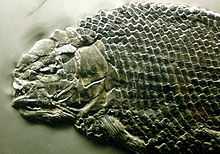Toadstone


The toadstone, also known as bufonite, is a mythical stone or gem thought to be found in a toad, and is supposed to be an antidote to poison. In this, it's not unlike Batrachite, supposedly formed in the heads of frogs. Items called toadstones were actually the fossilized teeth of Lepidotes, an extinct genus of ray-finned fish from the Jurassic and Cretaceous periods, as they appeared to be "stones that are perfect in form".[1]
Beliefs
At some point, people began to associate the fossils with jewels that some believed were formed, by supernatural means, in the heads of toads. They were first recorded by Pliny the Elder in the first century.[1]
According to Paul Taylor of the English Natural History Museum:
Like tonguestones, toadstones were considered to be antidotes for poison and were also used in the treatment of epilepsy".[1] As early as the 14th century, people began to adorn jewelry with toadstones for their magical abilities. In their folklore, a toadstone was required to be removed from an old toad while the creature was still alive, and as instructed by the 17th century naturalist Edward Topsell, could be done by setting the toad on a piece of red cloth.[1]
"Toadstone" is also an old miner's name for the basaltic intrusions into Derbyshire limestone.[2]
Allusions in literature
The toadstone is alluded to by Duke Senior in Shakespeare's As You Like It, in Act 2, Scene 1, lines 12 through 14:
Sweet are the uses of adversity;
Which, like the toad, ugly and venomous,
Wears yet a precious jewel in his head.
In James Branch Cabell's short story "Balthazar's Daughter" (collected in The Certain Hour) and its subsequent play adaptation The Jewel Merchants, Alessandro de Medici attempts to seduce Graciosa by listing various precious jewels in his possession, including "jewels cut from the brain of a toad".
Various other names
Some various other names of the toadstone are:
|
|
|
References
Further reading
- New Oxford American Dictionary, under the entry "toadstone".
- The Complete Works of William Shakespeare by Crown Publishers Inc
External links
- A collection of notes maintained by James Eason of the University of Chicago comprising excerpts from Thomas Nicols and other authors
- New York Times reference, October 1890
- "Whitehurst and the Volcanic Origin of Toadstone, 1778"
- "Toadstones: A note to Pseudodoxia Epidemica, Book III, chapter 13"
- Whitehurst, John (1713-1788). An inquiry into the original state and formation of the earth, pp 184-5, 190 and ff).